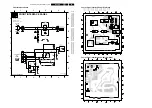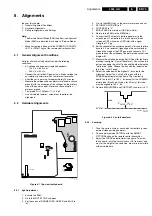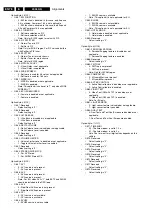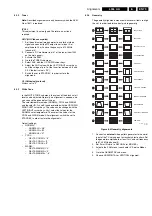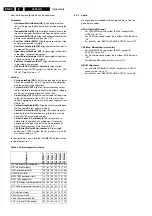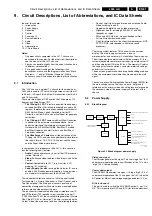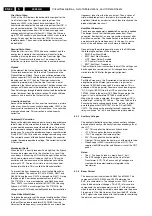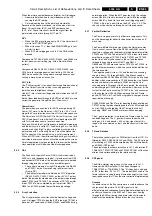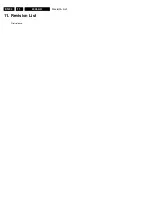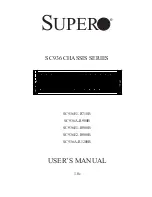
Circuit Descriptions, List of Abbreviations, and IC Data Sheets
9.
When the picture content becomes brighter, it will introduce:
•
Geometry distortion due to the impedance of the LOT
causing the EHT to drop.
•
Picture blooming due to the picture characteristics
Because of the above mentioned, we will need a circuit for
Beam Current Limiter (BCL) and EHT compensation
(EHT_info). These two circuits derive the signal from the
picture tube current info through LOT pin 10.
BCL
•
When the BCL pin voltage goes to 2.8 V, the Hercules will
start to limit CONTRAST gain.
•
When it reaches 1.7 V, then the BRIGHTNESS gain limit
will start to react.
•
When BCL pin voltage goes to 0.8 V, the RGB will be
blanked.
Components TS7483, R3490, R3491, R3492, and C2483 are
for fast beam current limiting (e.g. with a Black-to-White
pattern).
Components R3454, D6451, D6450, C2453, R3493, and
C2230 are for average beam current limiting. C2453 and
R3493 also control the timing where average beam current
limiting is more active or less active.
EHT_info
The “PHI2 correction” is to correct the storage time deviation of
the Line Output Transistor, which is causing geometry
distortion due to brightness change.
Line EHT_info is to correct the geometry distortion due to EHT
deviation.
Both of them feedback through the EHTO and PH2LF pin, and
correct the geometry through the East-West circuit.
Power Down
The power down connection is for EHT discharge during AC
Power “Off” state. In the Hercules, if EHT_info > 3.9 V, it will
trigger the X-ray protection circuit via a 2fH soft stop sequence.
The Hercules bits OSO (Switch Off in Vertical Over scan) and
FBC (Fixed Beam Current Switch Off) will discharge the EHT
with 1mA cathode current at over-scan position.
During switch-off, the H_out frequency is doubled immediately
and the duty cycle is set to 25% fixed, during 43 ms. The RGB
outputs are driven “high” to get a controlled discharge of the
picture tube with 1 mA during 38 ms. This will decrease the
EHT to about half the nominal value (= safety requirement).
When bit OSO is set, the white spot/flash during switch-off will
be written in overscan and thus will not be visible on the screen.
Careful application must guarantee that the vertical deflection
stays operational until the end of the discharge period.
9.3.5
DAF
The Dynamic Astigmatic Focus (DAF) circuit is required by
34RF sets only (depends on region). It provides vertical DAF
and horizontal DAF. Both of the parabola signals are derived
through integration by using chassis available signals:
•
The vertical parabola is using RC integration (via R3403
and C2401) on the Frame sensing resistor saw tooth
(Frame_FB).
•
The horizontal parabola is obtained by 2 RC integration
(R3409, R3410, C2402, C2403) on the +9V LOT output.
Both of the parabolas are added on the output stage through
adder TS7402 and TS7403. The collector of TS7402 emitter-
drives TS7401 and is amplified by pull up resistor R3411.
D6401 and C2405 provide the rectified supply voltage.
9.3.6
X-ray Protection
The X-ray protection circuit rectifies the filament voltage and
uses it to trigger TS7481 when the EHT is too high. TS7481 is
biased at “off” condition by D6480, R3482, and R3483 during
normal operation. When the EHT goes too high, the voltage
across R3482 will tend to increase as well, while the voltage
across D6481 is fixed. Up to certain level (triggering point),
TS7481 will be “on” and will force the EHT_info > 3.9 V. The
chassis will be shut down through a soft stop sequence.
9.3.7
Vertical Deflection
The Frame stage consists fully of discrete components. This
has the advantage for better flash behavior than when an IC
was used.
The Frame differential drive signal from the Hercules comes
from a current source. Resistors R3460 and R3461 convert
them into a voltage, and feed them into the differential amplifier
TS7455 and TS7456. The output of TS7456 is input to the next
amplification stage of TS7452. Finally, TS7451 and TS7453
deliver the Vertical yoke current to the coil and feedback
through the sensing resistors R3471 and R3472.
D6458 and TS7454 are used to bias TS7451 and TS7453, to
get rid of zero crossovers, which can cause horizontal lines at
the screen center.
The negative supply is from -12V and the positive scanning
supply is from +12V through D6459. The flyback supply is
derived from D6455, D6456 and C2456. This circuit is a voltage
doubler, which stores energy in C2456 during the Line flyback
period and delivers the energy to C2465 during the Line
scanning period. Throughout the Frame period, the charging
and discharging of C2456 works alternatively. However, at the
first half of the Frame scanning, TS7451 is “on” and consumes
all the charge from C2456. When entering 2nd half Frame
period, TS7451 is “off”, so C2456 will gradually charge up to the
required flyback supply.
C2463, R3464 and D6457 are for boosting the base voltage of
TS7451 during the flyback period and the 1st half Frame period
as well. C2463 is charged by D6457 during the 2nd half
scanning. R3467 and R3468 are for oscillation damping.
The V_guard protection is to protect the Frame stage if a fault
condition happens. The V_guard will sense the pulse with
voltage > 3.8 V and period < 900 us. Any signal out of this
range will be considered as fault, and the chassis will be shut
down.
9.3.8
Tilt and Rotation
The rotation control signal is a PWM output from the UOC. It is
filtered by R3252, R3246, R3259 and C2259. The DC voltage
after filtering at C2259 will be amplified by R3245 (Main Board)
and R3390 (CRT panel).
The output stage functions similarly as in L01.1 with rotation IC
TDA8941P. TS7331/TS7382 and TS7332/TS7381 will function
alternatively corresponding to the rotation setting.
9.3.9
CRT panel
The RGB amplifier stage is exactly the same as in L01.1.
However, the RGB amplifier IC has been changed to
TDA6107AJF or TDA6108AJF. The “A” indication is with gain
of “80” rather than “50” in L01.1. The diode D6332 used in the
former chassis, to solve the bright screen during start up, is not
required because this IC has the error correction implemented.
Scavem
In certain versions, the Scavem feature is used to enhance the
sharpness of the picture. The RGB signals are first
differentiated and subsequently amplified before feeding to an
auxiliary coil known as the SVM coil. The current, flowing
through the SVM coil during the picture intensity transients,
modulates the deflection field and thus the scan velocity.
Summary of Contents for L04LAA
Page 36: ...Service Modes Error Codes and Fault Finding EN 36 L04L AA 5 E_06532_012 eps 130204 ...
Page 58: ...58 L04L AA 7 Circuit Diagrams and PWB Layouts Layout Mono Carrier Part 1 Bottom Side Part 1 ...
Page 93: ...Spare Parts List EN 93 L04L AA 10 10 Spare Parts List Not applicable ...
Page 94: ...Revision List EN 94 L04L AA 11 11 Revision List First release ...


